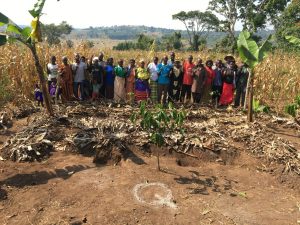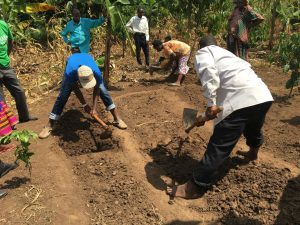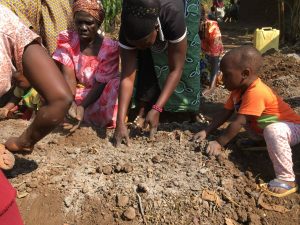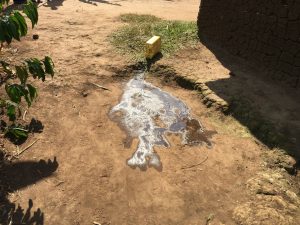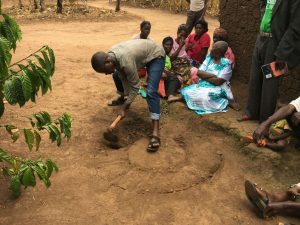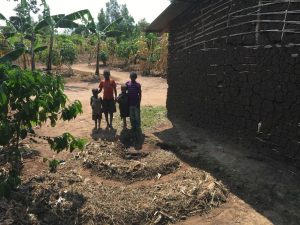This project is made possible through the partnership of WATER CHARITY and the NATIONAL PEACE CORPS ASSOCIATION. ![]()
This project has been completed. To read about the conclusion, CLICK HERE.
The ninth training of our Permagarden Training Initiative – Worldwide will take place in July 2018. Peter Jensen will train community volunteers with his Terra Firma Permagardens for Empowerment and Resilience course. Here is an outline of what will be accomplished in the training.
What:
To provide a complete, hands-on, Four Day Terra Firma Permagarden Creation and Outreach Training
Trainer:
Peter Jensen, RPCV (Haiti, 1985-87), Agroecology and Permagarden Training Specialist. Peter will be working with Gerald Nkusi, ALCDI Uganda, as a training assistant and co-facilitator.
Host and Local Direction:
Kasaana Peoples HIV Organization, supported by Richard Kyambadde, Uganda Team Leader for Friendly Water for the World.
Where:
Kasaana, Uganda
When:
July 15 – July 21, 2018
Who:
25 community outreach volunteers of Kasaana
Summary:
The Kasaana Peoples HIV Organization receives fairly regular support from Richard Kyambadde, Uganda Team Leader for Friendly Water for the World. A key focus of their work has been Bio-sand Filters as well as a few Ferro cement water catchment tanks. Gerald and Peter are pleased to be here this week to provide hands-on runoff water management and climate-smart gardening techniques to further support the group’s efforts in family nutrition.
They found an excellent site for the Perma garden workshop which is highly representative of the harsh soil and slope conditions of the area.
25 highly motivated men and women will be trained over 4 days on how to create and teach the standard 3x3m Permagarden as well as the new innovation, the Terra Firma Keyhole. The keyhole is a small-scale version of the Perma garden which is particularly suited for the corners of outdoor kitchens and those families with extremely small land availability. The keyhole still teaches all the Terra Firma Agroecological lessons of resource assessment, carbon capture, water management, and bio-intensive soil health management and intensive plant spacing as taught in the standard Permagarden.
Staff will provide monthly follow-up site visits with all trained individuals and encourage the continuing outreach of this small, doable action-oriented, nutrition security and water management approach.
The step-by-step Terra Firma Method will be used throughout to guide learners and future trainers on how to make the most suitable all-organic, water-conserving, nutrition-focused, home garden for this particular climate and culture.
Terra Firma guides the learner to make the most informed agroecological-appropriate garden but can also be used intersectoral in public health, youth development, and small enterprise development situations as well.
All actions within the workshop will foster independence rather than dependence upon outsiders to continue. The Terra Firma method uses only the tools, plants and soil amendments that are already locally accessible to targeted beneficiaries, namely rural poor farmers, mothers, and children, enabling further adoption within the local community following training by these soon-to-be trainers.
Garden Spot Before. Weak maize, the dominant crop, being grown in shallow compacted and infertile soil can be completely renovated to capture the runoff from the roof in deeply dug garden beds and swales.
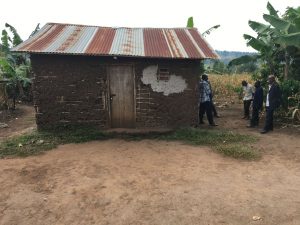
Barren Landscape. This is typical of homes across Uganda. The large compacted space in front is used as a grain drying area and cannot be disrupted but still presents a serious challenge when it comes to slowing the runoff before it causes erosion. This is a 25-square meter roof, which in this area where 1,400 mm or rainfalls throughout the year, results in 35,000 liters flowing into the lower sloping landscape. We are here to help these families capitalize on this bounty rather than be destroyed by it.

Corner Erosion. A huge amount of rain focuses its energy on the corner of the house. The small grass is a big help but not enough to slow the water before causing huge erosion. This area will become a perfect spot to demonstrate the Terra Firma Keyhole on the last day of the training as the group looks to bring the concepts to their own homes. All the lessons of the regular Perma garden can be taught at little risk as this effort only takes an hour and uses just locally accessible materials.

Corner Keyhole Opportunity. Seen from the downslope, this area of erosion can be converted simply into a ‘cubic meter’ garden complete with water capture hole, berms and double dug garden beds in concentric curves. Slowing and holding the water deep within the subsoil, this small area can produce a large amount of food at low risk.
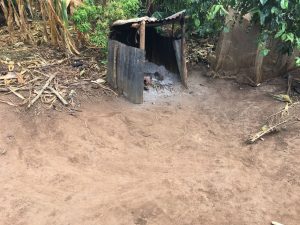
Kitchen Keyhole Opportunity. This tiny protected fire pit with its square meter of tin sheeting will perfectly highlight just how much water can be brought under control and utilized as a ‘cubic meter garden’. The copious amounts of organic matter that are inadequately utilized throughout the area will also be used to great effect as a subsoil amendment. This will help the soil hold huge amounts of water as well as release much needed fertility from the highly compacted soil.
Your donation using the button below will be used for the next Perma garden project.
 Conclusion of Kasaana Permagarden Training – Uganda
Conclusion of Kasaana Permagarden Training – Uganda
This project has been completed under the direction of Peter Jensen, Agroecology and Permagarden Training Specialist. The training was hosted and locally organized by Kasaana Peoples HIV Organization, supported by Richard Kyambadde. Gerald Nkusi, ALCDI Uganda, worked as a training assistant and co-facilitator.
To read about the start of the project, CLICK HERE.
Peter reports:
This was another very successful training. This group of 25 men and women (and about 8 under 5s) was highly motivated from the start. They responded with enthusiasm when they learned our true intent was to help them all be able to create healthy soil that would serve as a runoff absorbing ‘water tank’.
Over the course of 4 days these farmers learned the vital role that a small space managed well can play in their family food security. They designed the garden for runoff control then healed the soil then planted close. These are big early adoption steps for these traditional, rural farmers and we have high expectations that they will be implementing these gardens across their villages.
The Fully Protected Permagarden: After just a few days the fully protected, planted and mulched Permagarden is ready to receive and hold the runoff coming from the nearby hard slope and roof. Over the course of the year, over 40,000 liters of runoff water will be brought under control to nourish the year-round crops to be grown in this family-based home garden.
Water Management By Design: The berms and swales protect the garden beds within allowing this space to not only minimize the impact of the maximum rains but also maximize the value of the minimal rains.
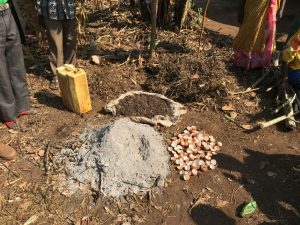
Local Assets: Many of the participants were surprised to learn of the many valuable materials formerly thought of as being of little value: Egg shells, wood ash, coarse brown materials, forest soil, and manure are all used to improve the quality and water retention ability to these compacted clay soils. And, by being locally accessible, they are by definition, NO COST.
Topsoil Feeding: This gentle activity is suitable for all ages! Regular feeding of the topsoil will enhance crop production and reduce waste and water loss at the same time.
Lost Runoff: Every time it rains, this area becomes more and more eroded and more and more water is lost. This is just what 10 liters of water looks like. Imagine when it is over 3,000 which is what will flow over this spot during a 20-minute moderate shower.
Controlling the Runoff: But with simple planning and digging and amending the soil, this waste area is transformed into a water holding Keyhole Garden.
The Finished Keyhole: I now refer to this as Cubic Meter Gardening. What had been 4 square meters of highly eroded waste area is now 8 cubic meters of highly productive root and shoot growing area. A rich soil, teeming with life and copious amounts of water will yield a bounty of food close to the home and close to the observant eyes of the children.
We extend our thanks to Peter for completing this important project.
